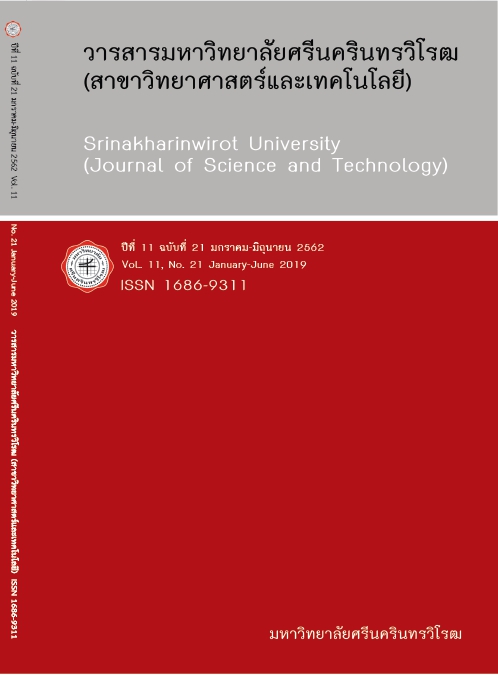ความสัมพันธ์ระหว่างการปนเปื้อนออร์แกโนฟอสเฟตในกระแสเลือดของเกษตรกรสวนผักกับความรู้และพฤติกรรมของเกษตรกรในจังหวัดร้อยเอ็ด ASSOCIATION OF ORGANOPHOSPHATE CONTAMINATION IN BLOOD OF VEGETABLE FARMERS WITH THEIR KNOWLEDGE AND BEHAVIOR IN ROI ET PROVINCE
Keywords:
Vegetable Farmers, Pesticides, Organophosphates, Acetylcholinesterase EnzymeAbstract
Acetylcholinesterase (AChE), an enzyme that breaks down a neurotransmitter acetylcholine, prevents overstimulation of post-synaptic nerves and muscles. Organophosphates (OPPs) are AChE inhibitors widely used as pesticides in vegetable production. Thus, OPP contamination in vegetables entering human blood circulation can be toxic to neurological system. Purposes of this research were divided into 2 folds 1) to determine the level of AChE, an inverse biomarker enzyme for OPPs present in the blood of vegetable farmers and 2) to investigate association between the level of AChE with the level of knowledge and level of behavior on pesticide uses of vegetable farmers in a village of Roi Et province, Thailand. Forty-six subjects who have been working in vegetable farms were recruited. Basic demographic data showed that 100% of subjects used OPPs, but only 6.5% were certified with the Good Agricultural Practice (GAP). Most of them had high level of knowledge (90.7%) and behavior (81.4%) on pesticide uses. Blood samples were collected from ring finger tips with lancets and capillary tubes. A reactive paper finger-blood test (Bigg’s method) was used to measure AChE level. Results showed that 24 blood samples had normal level of AChE whereas the other 19 samples were abnormal. Pearson's chi-squared test was further used to determine an association between the levels of knowledge and behavior with the level of AChE. No association neither between the level of knowledge with blood AChE level in vegetable farmers (c2 = 0.935, df = 3, p = 0.817) nor between the level of behavior and blood AChE level in vegetable farmers (c2 = 5.303, df = 3, p = 0.151) was observed. Lastly, an intervention program was employed to improve the farmer’s behavior according to the GAP for Food Crop and Pesticide Hazard Prevention Guidelines for 7 days and was found that their AChE tended to return to the normal level.
Downloads
References
[2] Kongtip P, Nankongnab N, Mahaboonpeeti R, Bootsikeaw S, Batsungnoen K, Hanchenlaksh C, Tipayamongkholgul M; & Woskie S. (2018). Differences among Thai agricultural workers' health, working conditions, and pesticide use by farm type. Ann Work Expo Health. 62(2): 167- 181.
[3] Hongsibsong S, Kerdnoi T, Polyiem W, Patarasiriwong V; & Prapamontol T. (2015). Organophosphate pesticide exposure of farmers in Chiang Mai Province, Northern Thailand. In the Proceeding of the International Conference on Advances in Environmental Research. 87(13): 73-76.
[4] Eddleston M, Buckley N, Eyer P; & Dawson AH. (2000). Management of acute organophosphorus pesticide poisoning. The Lancet. 371(9612): 597-607.
[5] Hung DZ, Yang HJ, Li YF, Lin CL, Chang SY, Sung FC; & Tai SC. (2015). The long-term effects of organophosphates poisoning as a risk factor of CVDs: A nationwide population-based cohort study. PLoS One. 10(9): e0137632.
[6] Danutra V. (2004). Development of Tracking System for Hazardous Substances Listed in Hazardous Substance Act. National Center of Excellence for Environmental and Hazardous Waste Management, Chulalongkorn University; Bangkok, Thailand Research Fund.
[7] Srithamma S, Vitthayarungruangsri J; & Posayanonda T. (2010). Food Safety Programme: A Key Component for Health Promotion. Bangkok: Thailand Food and Drug Administration. www.fda.moph.go.th/project/foodsafety
[8] Wongsprawmas R, Canavari M; & Waisarayutt C. (2014). Food safety assurance system for fresh produce production in Thailand: a review. Quality Assurance and Safety of Crops & Foods. 7(1): 73-88.
[9] Kachaiyaphum P1, Howteerakul N, Sujirarat D, Siri S; & Suwannapong N. (2010). Serum cholinesterase levels of Thai chilli-farm workers exposed to chemical pesticides: prevalence
estimates and associated factors. J Occup Health. 52(1): 89-98.
[10] National Bureau of Agricultural Commodity and Food Standards, Ministry of Agriculture and Cooperatives. (2013). Good Agricultural Practices for Food Crop. Retrieved March 3, 2018, from www.acfs.go.th/standard/download/eng/GAP_Food_Crop.pdf
[11] Food Safety Operation Centre, Ministry of Public Health, Thailand. (2009). Desk Analysis for Thailand Food Safety Programme External Review. FINAL REPORT.
[12] Namwong N, Howteerakul N, Sujirarat D; & Supanpong N. (2011). Factors affecting serum cholinesterase Level among Grape Farm Workers Exposed to Chemical Pesticides in
Samutsakorn Province. Thesis, MSc. (Public Health). Bangkok: Faculty of Graduate Studies Mahidol University.
Downloads
Published
How to Cite
Issue
Section
License
Srinakharinwirot University Journal of Sciences and Technology is licensed Under a Creative Commons Attribution-NonCommercial-NoDerivs 4.0 International (CC-BY-NC-ND 4.0) License, Unless Otherwise Stated. Please Read Journal Policies Page for More Information on Open Access, Copyright and Permissions.



